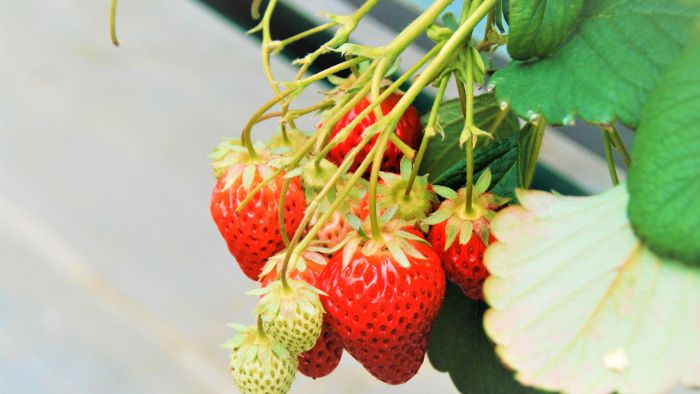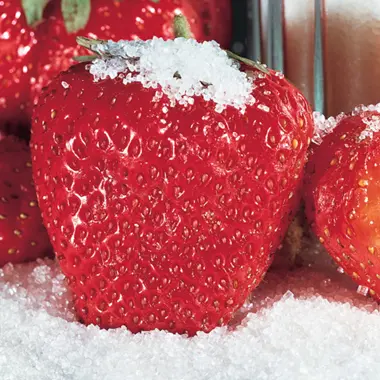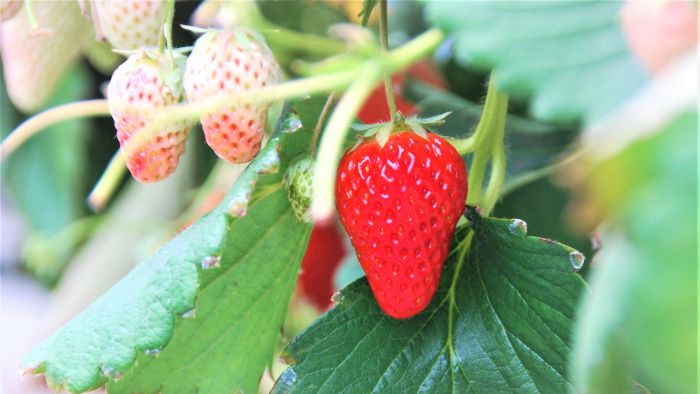Last Updated on December 14, 2024 by Sara Rose
Would you like to know the best hydroponic strawberry varieties that you can grow your own strawberries in the comfort of your own home?
If you answered yes to the above question, I completely understand you! Growing strawberries hydroponically can be a fun and interesting way to grow these berries. It is an efficient, clean way of doing it that can quickly become your preferred method of growing your favorite berries.
Even though it is an unconventional way (although that is rapidly changing), there are many benefits to growing strawberries in a hydroponic system. All you need is a hydroponic system, determination and the help that this guide is going to give you.
Table of Contents
Why Grow Strawberries Hydroponically?
Growing crops using hydroponics means growing them in a soilless medium. In a hydroponics system, a medium other than soil is used for the plants to attach their roots. Common hydroponics growth media include Rockwool, clay pebbles, coconut fiber and perlite.




This soilless medium is then provided with a nutrient rich solution to help support the growth of the plants.
Some of the advantages of growing strawberries hydroponically are:
- Low maintenance
Hydroponics systems require an initial investment to learn how everything operates, but since you’ve gotten the hang of it, it is very easy to maintain. You don’t have to worry about dirt from the soil, you can have a fully automated system that is self run.
- High yield
Once your hydroponics system has established, you can get really high yields from your strawberry plants than you would from soil grown ones.
- Constant production
Because you can put your hydroponics system in a greenhouse where you can manipulate the growing condition, you can harvest your strawberries all year round!
- Avoid soil borne pests
Growing your strawberries in a hydroponics system means that you avoid having to deal with any soil borne pests that would otherwise damage or even destroy your harvest. You, therefore, don’t have to worry about using pesticides. When the fruit is ready, you simply harvest from the plant and eat it.
- Stack vertically
You can stack your strawberry hydroponic systems vertically to maximize the use of space. This will enable you to produce and harvest more strawberries per unit area.

What Are The Best Strawberry Varieties To Grow Hydroponically?
There are three different types of strawberries, these are; June-bearing, ever-bearing and day-neutral. The differences between these types are their production times. The June-bearing type produces large berries only once per year, ever-bearing three times a year, and the day-neutral fruit and flower all year round. Our advice would be to plant ever-bearing strawberry varieties in your hydroponics system, because they are easier to manage and fruit at different times of the year. These are the best varieties of strawberries to grow hydroponically. And yes, these varieties are ever-bearing;
Mara de bois – a small, high yield strawberry variety known for its exceptional flavor, which combines the sweetness of traditional strawberries with a hint of wild berry richness.

Albion – This variety is known for its large, flavorful berries and high yield potential. It is a day-neutral variety, meaning it will produce fruit throughout the growing season.

Seascape – Seascape: Another popular choice, Seascape strawberries are known for their sweetness and disease resistance. They have a long fruiting period and produce medium-sized berries.

Quinault – is an early-bearing strawberry variety known for its large size and self pollination.

Tribute – this variety produces medium to large berries with a sweet and tangy flavor.

Do Strawberries Grow Well Hydroponically?
Yes, strawberries grow really well hydroponically. As long as you have a well functioning system and a sufficient provision of nutrients, there is no reason why your strawberries will not grow well. Here are the growing conditions to provide your strawberries in an aquaponics system;
Growing Conditions
Because a hydroponics system is primarily a water system, the conditions or parameters that you need to pay careful attention to it the water quality.
- pH – a pH value of between 5.5 and 6.0 is ideal. Use a pH meter to ensure that your pH remains within range

- Salt concentration – keep your total salt concentration between 800 and 900 ppm during the early stages of growth, and lower it to 400-500 ppm during the fruiting and flowering stages
- Temperature – keep your water temperature between 65 and 72 degrees F for optimum growth
- Sunlight – strawberries need a minimum of 6 hours of natural light, or 12 – 14 hours if you are using artificial light
- Humidity – keep humidity low
- Pruning – pinch or cut off any runners to help your plant increase growth and productivity.

Do Hydroponic Strawberries Taste Good?
Fruits such as strawberries tend to pick up flavors from the environment in which they are grown. In a particular study from 2015, participants indicated that hydroponically grown strawberries were sweeter than those grown in soil. This was considered to be caused by the increased nutrients and oxygen access that the plant roots had access to.
What Is The Difference Between Hydroponic Strawberries And Regular Strawberries?
There is no difference in the look or appearance of strawberries grown hydroponically and their soil-grown counterparts. The major difference is how they are grown. Either in soil or in a soilless medium, otherwise, the fruit is exactly the same. The state may be slightly different, as indicated in the abovementioned study.
Are Hydroponic Strawberries Grown Without Pesticides?
In a hydroponics medium, there is no soil to harbor pests. Therefore, hydroponic strawberries do not require the use of pesticides. This may be why these are preferred over the soil grown varieties.
Take Home Message – Best Hydroponic Strawberry Varieties
There you have it, the best strawberry varieties for hydroponics. We hope this article has ignited your interest in setting up your own hydroponic system and growing your own strawberries. Remember that it will take anywhere between 90 and 120 days for you to harvest your ripe strawberries. Make sure that your system is running well and that you are providing your plants with the right nutrients containing both macro- (nitrogen, phosphorus, and potassium) and micronutrients (calcium, magnesium, and sulfur).
It will require a bit of time investment on your part, learning how a hydroponic system works, and deciding on the variety of strawberries that will be best for you. But once you have that sorted, you are well on your way to having a constant provision of strawberries. Wouldn’t you want to just wake up, pick and bite into a juicy strawberry whenever you like? So what are you waiting for? Go ahead and get started. The best part is you don’t even need a garden to do it!
If you enjoyed reading this article, please feel free to share it with your friends and family.

An aquaculture specialist and freelance writer. Passionate about anything sustainable living, such as growing your own food, and if you can do it in conjunction with fish farming, even better! I currently work as an aquaculture researcher where I can expand and share my knowledge and skills on aquaculture, crop farming and adding value to wastewater by using it to grow food products. I enjoy reading and learning as much as possible, and writing is another avenue for me to share the knowledge I gain with others. I want my writing to inspire people to try their hand at gardening, whether indoors or outdoors. You can even start by keeping a few houseplants indoors to help you gain a bit of confidence if you need to.
